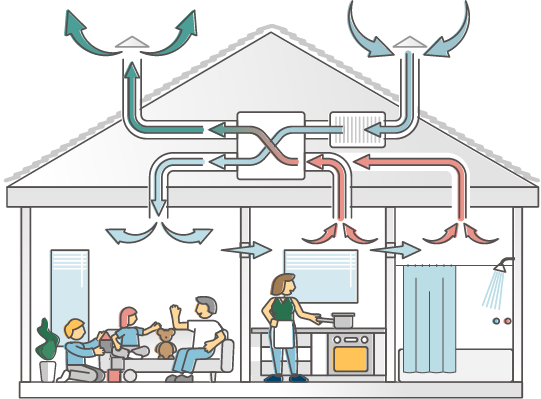Understanding the Relevance of Home Ventilation for a Healthier Living Atmosphere
Home ventilation plays a necessary role in preserving a healthy living atmosphere. It helps with the exchange of outdoor and indoor air, which is necessary for improving air top quality. Without correct ventilation, homes can end up being breeding premises for pollutants and allergens. The consequences of inadequate air circulation can be significant. This brings up the questions of just how home owners can properly apply air flow methods to secure their wellness and health. Recognizing these approaches is vital.

The Essentials of Home Air Flow
Home ventilation works as an essential component of indoor air quality and convenience. It entails the procedure of exchanging stale interior air with fresh outdoor air, thus minimizing humidity and regulating temperature. Proper air flow systems can consist of all-natural techniques, such as open home windows and vents, as well as mechanical systems, such as exhaust followers and air exchangers. Reliable home air flow helps protect against issues like indoor mold growth and the build-up of damaging bits. It additionally boosts general energy performance, as well-ventilated areas can preserve comfy temperature levels with much less dependence on heating and cooling down systems. Recognizing the fundamentals of home ventilation is essential for property owners looking for to create a much healthier living environment for themselves and their families.

Usual Resources of Indoor Air Pollution

Lots of might not recognize it, indoor air contamination can stem from different resources within a home. Common factors include unpredictable organic compounds (VOCs) sent out from paints, solvents, and cleansing items. Household devices, such as gas ovens and fireplaces, can release harmful gases like carbon monoxide gas and nitrogen dioxide. Furthermore, mold and mildew prosper in damp locations, releasing spores that impact air quality. Pet dog dander, allergen, and pollen can accumulate indoors, more worsening air pollution levels. Cigarette smoking inside your home generates toxic chemicals that linger airborne. Finally, constructing materials, including asbestos and formaldehyde, can off-gas harmful materials. Recognizing these resources is necessary for preserving a much healthier indoor setting and promoting effective air flow methods.
Wellness Impacts of Poor Ventilation
Interior air contamination can have considerable health ramifications, specifically when air flow is poor. Poor ventilation can result in the buildup of harmful toxins, such as volatile organic compounds, mold, and particle issue. This buildup may lead to respiratory concerns, including asthma, allergies, and chronic obstructive pulmonary illness. People might experience symptoms like headaches, exhaustion, and inflammation of the eyes, nose, and throat. At risk populations, such as children and the elderly, go to browse around this web-site greater threat for extreme wellness results. Long-term exposure to improperly aerated atmospheres can also contribute to a lot more serious conditions, including heart diseases. As a result, ensuring correct air flow is vital for maintaining a healthy living environment and decreasing the risk of health difficulties connected with interior air contamination.
Effective Air Flow Techniques for Your Home
Correct air flow is vital for maintaining a healthy and balanced indoor atmosphere, and implementing reliable techniques can significantly improve air quality. Home owners can start by ensuring that exhaust followers are installed in bathrooms and kitchen areas to remove excess wetness and odors. Opening up windows regularly enables fresh air to distribute, especially throughout light weather. Furthermore, using air cleansers with HEPA filters can help catch air-borne toxins. For homes with heating and cooling down systems, maintaining cooling and heating systems and changing filters consistently is important for peak efficiency. Incorporating natural air flow strategies, such as cross-ventilation, can likewise boost air flow. Securing any kind of leaks in windows and doors stops undesirable drafts, which can interfere with controlled air flow, eventually leading to enhanced indoor air top quality and comfort.
Maintaining Optimal Air Quality Year-Round
To maintain excellent air quality year-round, property owners need to embrace an aggressive approach to managing their indoor setting. Routinely keeping an eye on interior air top quality is crucial; this includes monitoring for toxins such as dirt, mold and mildew, and unstable organic compounds (VOCs) Executing effective air flow systems, such as exhaust fans and air cleansers, can considerably reduce air-borne contaminants. In addition, regular upkeep of cooling and heating systems guarantees peak efficiency and air flow. House owners should also consider moisture levels, as excessive wetness can lead to mold growth. Seasonal changes might demand adjustments in ventilation techniques to fit differing outside air quality. By focusing on these methods, homeowners can develop a healthier living space, advertising general wellness for all residents throughout the year.
Often Asked Inquiries
Just How Can I Tell if My Home Demands Better Air Flow?
To figure out if a home calls for better air flow, one should observe indicators such as consistent moisture, mold and mildew growth, stuffy odors, condensation on windows, or boosted allergy signs and try here symptoms, suggesting poor air movement and potentially bad interior air high quality.
What Are the Indicators of Poor Indoor Air Quality?

Can Houseplants Improve Indoor Air Quality Successfully?
The performance of houseplants in enhancing interior air top quality is disputed. While some research studies suggest they can take in contaminants and create oxygen, their overall effect might be marginal compared to appropriate air flow and air purification systems.
Exactly how Frequently Should I Modification My Air Filters?
The frequency of air filter modifications normally depends on usage and filter kind. Normally, it is advised to replace filters every three months, though families with allergies or animals might call for more constant changes for suitable efficiency.
Exist Any Type Of Specific Ventilation Solutions for Allergic Reaction Sufferers?
Many ventilation systems, such as HEPA-filtered units, successfully minimize irritants airborne. Home Ventilation Melbourne. These systems catch plant pollen, dirt, and pet dog dander, providing allergy sufferers with a cleaner, navigate to this website healthier indoor atmosphere while taking care of air quality efficiently
It assists in the exchange of interior and outside air, which is vital for enhancing air high quality. Home ventilation serves as a crucial part of interior air quality and comfort. It entails the procedure of exchanging stale indoor air with fresh outdoor air, thus decreasing humidity and regulating temperature level. Indoor air contamination can have considerable health and wellness ramifications, especially when ventilation is insufficient. Proper air flow is essential for preserving a healthy and balanced interior atmosphere, and executing efficient approaches can substantially enhance air high quality.